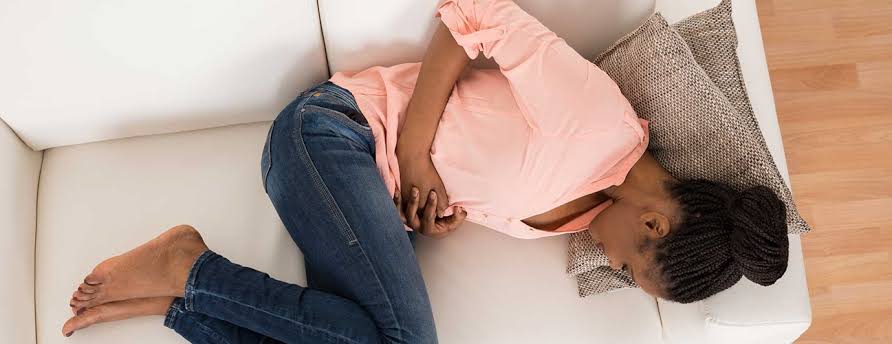One of the trickiest things for doctors to diagnose is stomach pain. Yet, it’s one of the conditions we don’t take seriously because we just assume it’s diarrhoea. Here are some types of stomach pain you can experience & the health issues that could be responsible.
1. Sudden pain that causes you to also vomit
This could also be a sign of foodborne illness like salmonella, shigella, campylobacter, or E.coli. It’s really no surprise that if you eat something off, your body might ‘protest’. However, these symptoms can also happen due to acute gastroenteritis, also known as the stomach flu. Gastroenteritis is an inflammation of the lining of the intestines that can be caused by a virus, bacteria, or parasite.

While it can be hard to tell the difference between food poisoning and the stomach flu (and sometimes they even overlap), one key differentiator is that gastroenteritis usually doesn’t cause bloody diarrhoea, while food poisoning often does. The good news is that gastroenteritis usually goes away on its own but if you’re struggling to keep fluids down (a common problem with gastroenteritis), it’s definitely time to see a doctor.
2. Intense pain accompanied by (bloody) diarrhoea
Unfortunately for you (and your toilet), this could be a sign of foodborne illness like salmonella, shigella, campylobacter, or E.coli. Also, the foodborne illness will usually also cause other symptoms like fever.
Some important questions to ask yourself:
1. Did you eat anything recently that you suspect might have been contaminated?
2. Do you know of anyone else who ate the same thing and now has similar symptoms?
Even though food poisoning often goes away within a few days, seeing blood in your poop is a good reason to see your doctor. This could suggest you’re dealing with a form of inflammatory bowel disease (IBD), like ulcerative colitis, a chronic, debilitating condition.
3. The pain has stuck around for more than a day, and it’s spreading into your back
Although the duration of pain is often not a reliable indicator of a serious condition, this kind of persistent pain can indicate a major health issue like acute pancreatitis or cholecystitis.
With pancreatitis (inflammation of the pancreas), the pain typically starts in your upper abdomen and may extend into your back from there. While that’s usually the main symptom, others include fever, nausea and vomiting, a quickened heartbeat & a swollen or tender abdomen. This pain is relief when you lean forward.
For cholecystitis (inflammation of the gallbladder), the pain may start from your upper right/centre abdomen before spreading to your right shoulder/back. Cholecystitis can also cause nausea, vomiting, fever & stomach tenderness. Both symptoms are similar so call your doctor.
4. You suddenly feel pain in your lower right abdomen and it’s getting worse
Appendicitis (inflammation of the appendix). This often starts around the belly button before moving to the lower right abdomen & it’s just awful. The pain usually becomes more intense within hours.
The pain may also get worse when you move around, take deep breaths, cough, or sneeze, and come along with symptoms like fever, nausea and vomiting, constipation, diarrhoea, and swelling. If you have these symptoms, don’t try to wait them out. Seek medical care immediately!
5. The pain is in your side or lower back, and it hurts to pee
It could be a kidney stone, which is a pebble-like piece of material that can form in one or both of your kidneys when you have high levels of certain minerals in your pee.
Kidney stones can vary in shape and size and while it’s possible to have one and not even know it, larger stones can cause incredible pain as they pass through your urinary tract on their way out of your body.
The pain usually comes and goes and may move toward the groin. It’s so intense that it can cause nausea, vomiting, and chills. In addition, you might also notice that your urine is pink, red, or brown due to blood.
Given how painful kidney stones can be, you probably don’t need us to tell you to see a doctor if you think you have them. Seriously, don’t try to tough it out!
6. You have intense stomach cramps in your lower abdomen, but you feel better after you poop
This can be a sign of irritable bowel syndrome (IBS), a disorder that’s related to how your brain and gut work together (or don’t). IBS can cause your gut to be more sensitive and change how the muscles in your bowel contract. That can lead to issues like persistent stomach pain, bloating, diarrhoea, constipation, etc. With IBS, the pain is usually in the lower abdomen and often improves after you poop.
Stomach cramps that recede post-poop can also sometimes be a sign of constipation. Since IBS can cause constipation, the lines are a bit blurred here. If these symptoms haven’t been an issue for you in the past, there’s a chance you’re just dealing with “regular” constipation.
However, if this is a recurrent thing for you, definitely mention that to your doctor and ask if it could be a sign of IBS based on other symptoms you may or may not have.
7. The pain is more intense during your period and has been getting worse over the years
Cramps are a normal (incredibly irritating) part of having a period, but it’s worth noting that you should see a doctor if your cramps have sneakily gotten worse over time.
If your cramps are worse now than they were a year ago (and way worse than they were before that), it could be a sign of endometriosis. Endometriosis is thought to happen when tissue that lines the uterus grows outside of your uterus on other organs.
That can lead to unbelievable pain that can show up in a variety of ways: period cramps, pain when you go to the bathroom, chronic pain in your lower back and pelvis, and pain during sex, along with other issues like heavy bleeding.
Bear in mind that pain from endometriosis can vary from person to person. There are ways to treat endometriosis pain, so don’t write it off as something you just need to deal with. Try to find a specialist who can help.
8. The pain is sudden, sharp, and on one side of your pelvis, followed by a dull pain in your lower abdomen
Sometimes this type of stomach pain signals a ruptured ovarian cyst – a (noncancerous) masses that often forms from the follicles that are a key part of ovulation.
If a follicle grows in preparation for ovulation but doesn’t actually burst to release an egg, as it should, that can create a cyst. Sometimes ovarian cysts don’t cause any symptoms and eventually go away on their own but if one bursts, it can hurt. A lot.
A ruptured ovarian cyst isn’t necessarily a problem, but if it’s especially painful or if you also experience fever, vomiting, cold and clammy skin, rapid breathing, and lightheadedness, call your doctor for help. Nothing beats an evaluation from an expert.
That’s all we’ve got on this topic and we hope it would be helpful to you. Do share with a friend or just retweet, you never know whose problem you might be solving. Do have a beautiful day.
Source: AvonHealthcare
Featured Image: John Hopkins





















